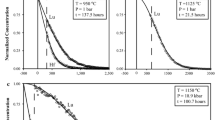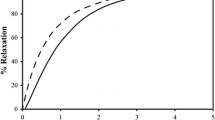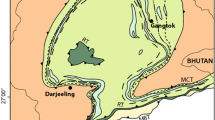Abstract
Compositional zoning of garnet in metamorphic or igneous rocks preserves evidence of the equilibration history of the sample and can be interpreted in terms of a growth-fractionation, diffusion-exchange, or diffusion-reaction model. Diffusion zoning is usually assumed to result from exchange reactions between garnet and other phases as the partitioning coefficient varies in response to changing environmental conditions, primarily temperature. However, in many natural environments where garnet grew originally in divariant equilibrium with other phases, changing conditions can promote continuous or “divariant” reactions and consequent compositional shifts of phases that can be much greater in some systems showing these reactions than those related to the small changes of partitioning. Diffusional zoning related to overstepping of these continuous reactions must be related to incongruent reaction and necessitates formulation of a kinetic diffusion-reaction model involving moving phase boundaries as well as solid-state diffusion.
Three samples containing zoned garnets from the metamorphic aureole around the Ronda ultramafic intrusion in southern Spain are used to illustrate two possible models of diffusion-reaction processes. The examples are particularly informative because the reactions are demonstrably irreversible and evidence of the reaction system is preserved. Partitioning data indicates that compositions of product phases are not in equilibrium with the original garnet and do not vary with extent of reaction; therefore, exchange reactions with garnet were not possible and garnet changed composition only by incongruent reaction. After a small amount of reaction, Mg/Fe of the rim composition approaches a value apparently in equilibrium with product phases, but the garnets are zoned inward to the original garnet composition preserved in the interior. Grossularite content is approximately constant and spessartite content variable but small, thus, the rim composition of pyrope or almandine is assumed to be fixed by the external reaction process and is taken as a boundary condition in the following models.
The zoning profile of pyrope or almandine component between the fixed rim and core compositions (assumed to extend to ∞) is described in semiinfinite, half-space models appropriate for large garnets with narrow rims. The first model corresponds to a reaction system in which all garnet compositions are metastable (case 1) and zoning depends on the independent variables of the diffusion constant, velocity of the interface between garnet and matrix, and time. The second model, corresponding to systems in which the initial garnet composition is metastable but an equilibrium composition is stable (case 2), depends on the independent variables diffusion constant, time, and a function of reaction compositions. In case 1 the consumption velocity is assumed constant and a steady state zoning profile is reached at large time, whereas, in case 2, the velocity decreases with the concentration gradient and steady state is not possible.
The models were tested using a reaction time estimated from cooling models of the aureole, mass of garnet consumed, determined petrographically, and phase compositions. The two cases are somewhat independent in that different parameters are independent variables. The estimate of the diffusion constant of 10−18±2 cm2/sec (assumed to be a mutual or binary coefficient for almandine and pyrope) is considered reasonable for the temperature range of reaction (probably 600–900° C), and the two models are consistent considering the probable error and possible real temperature differences.
It is obvious that details of the metamorphic reaction system must be known to successfully apply diffusion models. Kinetic models, involving consumption or growth of the phase as well as diffusion are probably necessary when dealing with natural rocks. Several possible and interesting complications, such as cross coupling between components, can be investigated if more data were available. Experimental determination of diffusion constants allow natural reaction rates to be estimated by this method. Diffusion zoning is an important consideration that could increase the efficiency of experimentation with chemically recalcitrant phases.
Similar content being viewed by others
References
Albarede, J., Bottinga, Y.: Kinetic disequilibrium in trace element partitioning between phenocrysts and host lava. Geochim. Cosmochim. Acta 36, 141–156 (1972)
Anderson, D.E., Buckley, G.R.: Zoning in garnets-diffusion models. Contrib. Mineral. Petrol. 40, 87–104 (1973)
Béthune, P. de, Laduron, D., Martin, H., Theunissin, K.: Grenats zones de la zone du Mont Rose (Valle Anzasca, Prov. de Novara, Italie). Bull. Suisse Mineral. Petrog. 48, 437–454 (1968)
Buening, D.K., Buseck, P.R.: Fe-Mg lattice diffusion in olivine. J. Geophys. Res. 78, 6852–6862
Carmichael, D.M.: On the mechanism of prograde metamorphic reactions in quartz-bearing pelitic rocks. Contrib. Mineral. Petrol. 20, 244–267 (1969)
Carslaw, H.S., Jaeger, J.C.: Conduction of heat in solids. Oxford: Oxford University Press 1959
Chinner, G.A.: Almandine in thermal aureoles. J. Petrol. 3, 316–340 (1962)
Crank, J.: The mathematics of diffusion. Oxford: Oxford University Press 1956
Evans, B.W., Guidotti, C.V.: The sillimanite-potash feldspar isograd in western Maine, U.S.A. Contrib. Mineral. Petrol. 12, 25–62 (1966)
Fisher, G.W.: Nonequilibrium thermodynamics as a model for diffusion-controlled metamorphic processes. Am. J. Sci. 273, 897–924 (1973)
Ganguly, J., Kennedy, G.C.: The energetics of natural garnet solid solution I. Mixing of the alumino silicate end-members. Contrib. Mineral. Petrol. 48, 137–148 (1974)
Grant, J.A., Weiblen, P.W.: Retrograde zoning in garnet near the second sillimanite isograd. Am. J. Sci. 270, 281–296 (1971)
Harte, B., Henley, K.J.: Occurrence of compositionally zoned almanditic garnets in regionally metamorphosed rocks. Nature 210, 689–692 (1966)
Hensen, B.J.: Cordierite-garnet equilibrium as a function of pressure, temperature, and iron-magnesium ratio. Carnegie Inst. Wash. Yearbook 71, 418–421 (1971)
Hess, P.C.: Prograde and retrograde equilibria in garnet-cordierite gneisses in south-central Massachusetts. Contrib. Mineral. Petrol. 30, 177–195 (1971)
Hollister, L.S.: Garnet zoning: An interpretation based on the Rayleigh fractionation model. Science 154, 1647–1651 (1966)
Hollister, L.S.: Contact metamorphism in the Kwoiek area of British Columbia. An end member of the metamorphic process. Bull. Geol. Soc. Am. 80, 2465–2494 (1969)
Leake, B.E.: Zoned garnets from the Galway granite and its aplites. Earth Planet Sci. Lett. 3, 311–316 (1968)
Loomis, T.P.: Diapiric emplacement of the Ronda high temperature ultramafic intrusion, southern Spain. Bull. Geol. Soc. Am. 83, 2475–2496 (1972a)
Loomis, T.P.: Contact metamorphism of pelitic rock by the Ronda ultramafic intrusion, southern Spain. Bull. Geol. Soc. Am. 83, 2449–2474 (1972b)
Loomis, T.P.: Irreversible reactions in high-grade metapelitic rocks. J. Petrol., in press (1975)
Mueller, G., Schneider, A.: Chemistry and genesis of garnets in metamorphic rocks. Contrib. Mineral. Petrol. 31, 178–200 (1971)
Richardson, S.M.: Cation exchange reactions and metamorphism of high-grade pelites in central Massachusetts. Geol. Soc. Am., Abst. with Programs 6, 1059 (1974)
Rosenfeld, J.L.: Garnet rotations due to the major Paleozoic deformations in southeastern Vermont. In: Studies of Appalachian geology: Northern and Maritime, Zen, E-an; White, W.S., Hadley, J.B., Thompson, J.B., eds. p. 185–202 New York: Wiley Interscience 1968
Rosenfeld, J.L., Chase, A.B.: Pressure and temperature of crystallization from elastic effects around solid inclusions in minerals. Am. J. Sci. 259, 519–541 (1961)
Author information
Authors and Affiliations
Rights and permissions
About this article
Cite this article
Loomis, T.P. Reaction of zoning of garnet. Contr. Mineral. and Petrol. 52, 285–305 (1975). https://doi.org/10.1007/BF00401458
Received:
Accepted:
Issue Date:
DOI: https://doi.org/10.1007/BF00401458




